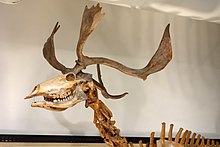中华大角鹿属
| 中华大角鹿属 化石时期:
| |
|---|---|

| |
| 矢部中华大角鹿(Sinomegaceros yabei),于国立科学博物馆展出 | |

| |
| 肿骨鹿(Sinomegaceros pachyosteus),于大庆博物馆展出 | |
| 科学分类 | |
| 界: | 动物界 Animalia |
| 门: | 脊索动物门 Chordata |
| 纲: | 哺乳纲 Mammalia |
| 目: | 偶蹄目 Artiodactyla |
| 科: | 鹿科 Cervidae |
| 亚科: | 鹿亚科 Cervinae |
| 族: | 鹿族 Cervini |
| 属: | †中华大角鹿属 Sinomegaceros Dietrich, 1933 |
| 种 | |
| |
| 异名 | |
| |
中华大角鹿属(学名:Sinomegaceros),又名肿骨鹿、中国大角鹿,是一属已灭绝的鹿科动物,生存于早更新世至晚更新世的中亚和东亚,被认为是"巨型鹿群体"(通常称做Megacerini)的成员,可能是大角鹿属的亚属。该属以独特的掌状鹿角而闻名。
分类学
[编辑]

1932 年中国古生物学家杨锺健根据来自周口店的化石材料命名了被归类为鹿属的肿骨鹿和河套大角鹿。[2] 德国古生物学家威廉·奥托·迪特里希在次年的一篇论文评论中建立中华大角鹿亚属作为鹿属的亚属,并使用肿骨鹿当作模式种[3] 由于该名称没有在正式的研究论文中发表,因此在发表后的几十年里并未得到广泛使用,[4]矢部中华大角鹿在1938年被命名。[5]
在接下来的几十年里,各研究人员认为牠是大角鹿属的亚属,[6][7]或者是有效的属。[8][9] 一些已建立的种可能是异名。[4]
最著名的物种是生存于日本的中更新世至晚更新世的矢部中华大角鹿(学名:S. yabei),与生存于中国的早更新世晚期至晚更新世的肿骨鹿(学名:S. pachyosteus) 。
古生态学
[编辑]肿骨鹿(S. pachyosteus)具有肿厚的下颌,食性可能像马和水牛一样会摄食有富含纤维的草。[10]
演化
[编辑]目前发现最古老的物种是发现于中国丽水层下部的公王岭大角鹿(S. konwanlinensis),出现在110至115万年前。 肿骨鹿(S. pachyosteus) 约在100万年前出现。已知最年轻的物种是发现于鄂尔多斯市的河套大角鹿(S. ordosianus),出现在3.5至5万年前。矢部中华大角鹿(S. yabei)则最早出现在日本的中更新世后半期。[11] 矢部中华大角鹿(S. yabei)和肿骨鹿(S. pachyosteus)可能源自公王岭大角鹿(S. konwanlinensis)。[4]虽然中华大角鹿被认为在12000年前灭绝,但由于缺乏精准的放射性碳定年法,因此不确定中华大角鹿的准确灭绝时间。 [12]
与人类的关系
[编辑]在日本长野县野尻湖的野尻湖遗迹群出土了具有37900年至60400年历史的化石,同时还发现了许多石器和骨器,表明该物种曾被人类猎杀。[13]
参考
[编辑]- ^ Vislobokova, I. A. Morphology, Taxonomy, and Phylogeny of Megacerines (Megacerini, Cervidae, Artiodactyla). Paleontological Journal. 2013, 47 (8): 833–950. ISSN 0031-0301. S2CID 86697746. doi:10.1134/S0031030113080017 (英语).
- ^ Young, C.C., 1932. On the Artiodactyla from the Sinanthropus site at Chouk’outien. Palaeontogia Sinica, Series C 8 (2), 159
- ^ Dietrich, W.O., 1933. [Review of] C.C. Young: on the Artiodactyla from the Sinanthropus Site at Choukoutien. Neuest Jahrbuch fu ̈r Miner-alogie, Geologie und Pala ̈ontologie. Referate, III 1933(2), 475–477.
- ^ 4.0 4.1 4.2 van der Made, J.; Tong, H.W. Phylogeny of the giant deer with palmate brow tines Megaloceros from west and Sinomegaceros from east Eurasia (PDF). Quaternary International. March 2008, 179 (1): 135–162 [2023-03-31]. Bibcode:2008QuInt.179..135V. doi:10.1016/j.quaint.2007.08.017. (原始内容存档 (PDF)于2023-03-28) (英语).
- ^ Shikama, T., 1938. Discovery of giant fallow deer from the Pleistocene in Japan. Japanese Journal of Geology and Geography 16 (1–2), 115–122
- ^ Kahlke, H.D., Hu, C.-k., 1957. On the distribution of Megaceros in China (页面存档备份,存于互联网档案馆). Vertebrata PalAsiatica 1 (4), 273–283 pl. 1.
- ^ Kahlke, R.D., 1999. The history of the origin, evolution and dispersal of the Late Pleistocene Mammuthus-Coelodonta faunal complex in Eurasia (large mammals). Mammoth site of Hot Springs, SD, inc., 219.
- ^ Shikama, T., Tsugawa, S., 1962. Megacerid remains from Gunma Prefecture, Japan. Bulletin of the National Science Museum 6 (1), 1–13.
- ^ Otsuka, H., Shikama, T., 1977. Studies on fossil deer of the Takao Collection (Pleistocene deer fauna in the Seto Inland Sea, West Japan— Part 1). Bulletin of the National Science Museum 3 (1), 9–40 pls. 1-6.
- ^ Finite element analysis of the hemimandible of the giant deer, Sinomegaceros pachyosteus, revealing its feeding potentialities
- ^ Vislobokova, I. A. Giant deer: Origin, evolution, role in the biosphere. Paleontological Journal. December 2012, 46 (7): 643–775. ISSN 0031-0301. S2CID 85385952. doi:10.1134/S0031030112070027 (英语).
- ^ Iwase, Akira; Hashizume, Jun; Izuho, Masami; Takahashi, Keiichi; Sato, Hiroyuki. Timing of megafaunal extinction in the late Late Pleistocene on the Japanese Archipelago. Quaternary International. March 2012, 255: 114–124. Bibcode:2012QuInt.255..114I. doi:10.1016/j.quaint.2011.03.029 (英语).
- ^ Kondo, Y.; Takeshita, Y.; Watanabe, T.; Seki, M.; Nojiri-ko Excavation Research Group. Geology and Quaternary environments of the Tategahana Paleolithic site in Nojiri-ko (Lake Nojiri), Nagano, central Japan. Quaternary International. April 2018, 471: 385–395 [2023-03-31]. Bibcode:2018QuInt.471..385K. doi:10.1016/j.quaint.2017.12.012. (原始内容存档于2022-06-15) (英语).
